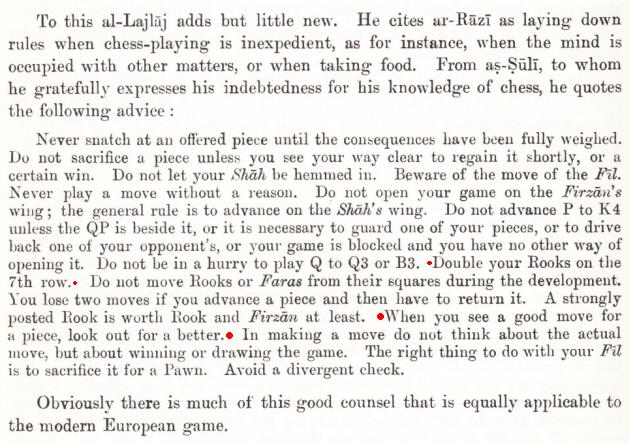
Edward Winter
Stuart Rachels (Tuscaloosa, AL, USA) asks about the observation ‘When you see a good move, look for a better one’, which he has seen ascribed, without a source, to Emanuel Lasker.
The phrase ‘without a source’ readily takes us, by way of example, to Andrew Soltis. From page 300 of his book The Inner Game of Chess (New York, 1994):
‘White failed to heed Emanuel Lasker’s sage advice: When you see a good move, don’t make it immediately. Look for a better one.’
It is certainly true that the phrase has often been attributed to Lasker; see, for instance, a quote in Alfred Kreymborg and Chess.
It has also been attributed to Tarrasch, and not always favourably. From page 36 of Better Chess by Bill Hartston (London, 1997):
‘But when you’ve fumbled and analysed, and all the signposts point to one particular move, when is the moment to sign contracts and play it? The great German player Dr Siegbert Tarrasch advised: “When you’ve found a good move, look for a better one.” What nonsense! When you’ve found a good move, play it! Good moves are few and far between. Don’t talk yourself out of them. But make sure they are as good as you think.’
A related point regarding Tarrasch was made by Capablanca on page 71 of A Primer of Chess (London, 1935), in the section headed ‘Main rules and ethics of the game’:
‘Do not hover over the pieces too much. It is unethical and it leads to errors. The celebrated German master, Dr Tarrasch, used to sit with his hands under his thighs to avoid hesitation and to keep from moving hastily. It is not bad to move quickly, but it is bad to move hastily.’
Next, a paragraph from page 78 of Chess Catechism by Larry Evans (New York, 1970):
‘It was Steinitz who observed that when you see a good move, wait – and look for a better one.’
Exact citations will be welcome, and in the meantime we offer a comment by Leopold Hoffer in the The Field, 1886, which was quoted on page 121 of Johannes Zukertort Artist of the Chessboard by Jimmy Adams (Yorklyn, 1989):
‘If Zukertort sees a good move, he makes it; if Steinitz sees a good move, he looks out for a better one.’
Many other such remarks could be quoted, but in any case the sentiments in question were expressed 500 years ago by Damiano in Questo libro e da imparare giocare a scachi et de le partite, as noted, for instance, by H.J.R. Murray on page 788 of A History of Chess (Oxford, 1913): ‘when you have a good move look for a better’. See too page 95 of Wonders and Curiosities of Chess by Irving Chernev (New York, 1974), in a feature entitled ‘Damiano’s centuries-old advice still good today’.
(7837)
We add the details regarding the Field quote which were omitted by Jimmy Adams: it appeared on page 565 of the 1 May 1886 edition.
The translation of Damiano’s observation in an article on him by J.A. Leon on pages 429-437 of the November 1894 BCM:
‘If you have a good move, look out whether there is not a still better one.’
Mark N. Taylor (Mt Berry, GA, USA) points out the following on page 246 of A History of Chess by H.J.R. Murray (Oxford, 1913):

The advice ‘Double your Rooks on the 7th row’ is also of interest, being relevant to the question asked in C.N. 6844.
(7841)
Below is part of C.N. 8652, which showed extracts from pages 12-13 of Combinations The Heart of Chess by Irving Chernev (New York, 1960):
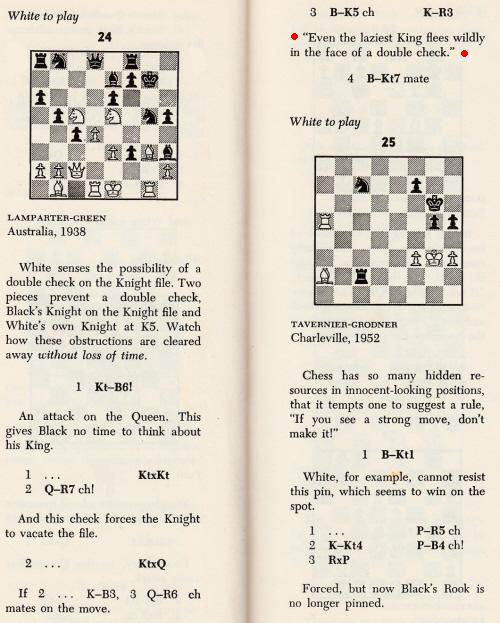
It will be seen that Chernev wrote:
‘Chess has so many hidden resources in innocent-looking positions that it tempts one to suggest a rule, “If you see a strong move, don’t make it!”’
From page 105 of Chess Rules of Thumb by Lev Alburt and Al Lawrence (New York, 2003):
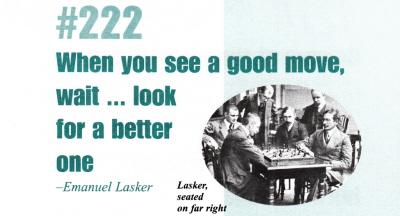
The advice attributed to Lasker is many, many centuries older, as shown in C.N.s 7837 and 7841. Nor should Lasker’s name appear in connection with the well-known photograph, which was the frontispiece to Der Schachwettkampf Schlechter-Tarrasch (Leipzig, 1912):
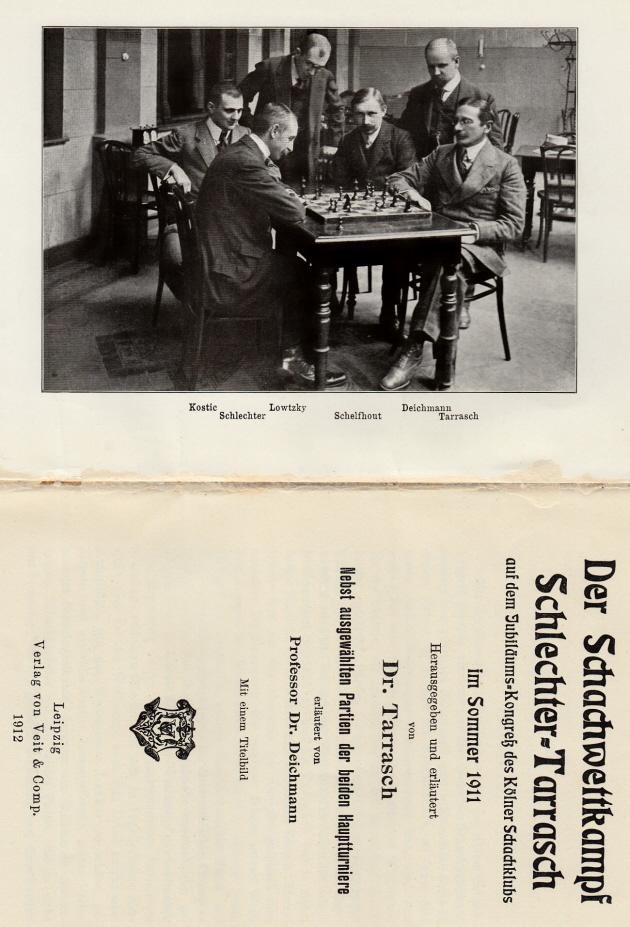
(8738)
C.N. 7837 quoted a remark by Capablanca on page 71 of A Primer of Chess (London, 1935):
‘Do not hover over the pieces too much. It is unethical and it leads to errors. The celebrated German master, Dr Tarrasch, used to sit with his hands under his thighs to avoid hesitation and to keep from moving hastily. It is not bad to move quickly, but it is bad to move hastily.’
Did Tarrasch ever recommend the practice in his writings, and, in any case, who was the first to make such a recommendation?
Page 263 of book two of The Middle-Game by M. Euwe and H. Kramer (London, 1965) has the following:
‘Apart from the usual advice to weigh up everything carefully and to practise self-control, the best advice is that given by “Woodshifter”, a regular contributor to the American monthly Chess Review – “Sit on your hands!”’
For ‘Woodshifter’ read ‘Woodpusher’. The relevant ‘Tales of a Woodpusher’ article by Fred M. Wren was entitled ‘It helps to sit on your hands’ and appeared on pages 28-29 of the May 1947 Chess Review. The key section:
‘Having decided early in my chess experience never to touch a piece without moving it and never to take back a move already made, I found that, although I lost a lot of games after I learned to sit on my hands, I was also winning a lot which could easily have been lost through hurried, unconsidered moves. So, for what it is worth, here is my advice to all players who have trouble in keeping their hands off the chess pieces.
1. Sit on your hands! Yes, I mean it. Sit on them and hold them down by the weight of your body until you have decided on your move. You will not have to keep this up very long before you can give up the physical weight on your hands, as you will quickly learn to sit on them mentally, with equally good results. But, in the meantime, sit on ’em!
2. Once you have decided what move to make, take another quick look at the position, both as it is before the move and also as it will look after you have made the move. Then, if the move still looks best to you, make it and abide by the results.
Never take a move back. If you adopt this practice in skittles and friendly play, you will never have any trouble on this point in match or tournament play.’
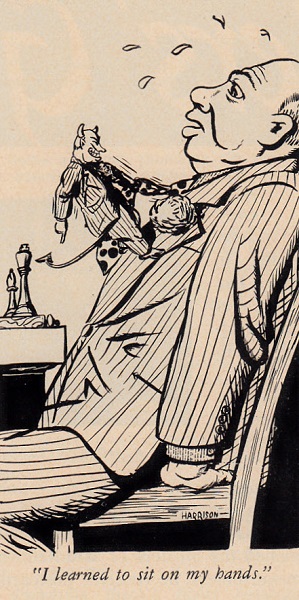
Source: Chess Review, May 1947, page 29
(8890)
From page 164 of Das Schachspiel by Siegbert Tarrasch (Berlin, 1931):
‘Wenn man einen starken, selbst einen entscheidenden Zug sieht, muß man sich immer die Frage vorlegen, ob es nicht einen noch stärkeren gibt!’
The English version on page 122 of The Game of Chess (London, 1935):
‘When one sees a strong, even a decisive move, one must always ask oneself if there is not a still stronger one.’
(9303)
C.N. 7837 referred to the text in Damiano’s 1512 work Questo libro e da imparare giocare a scachi et de le partite, and now Jean Fontaine (Montreal, Canada) points out that the phrase under discussion (‘Si hai bon trato per la mano guarda se nesia altro megliore’) can be viewed online.
(9309)
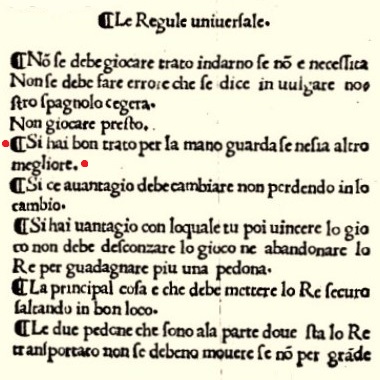
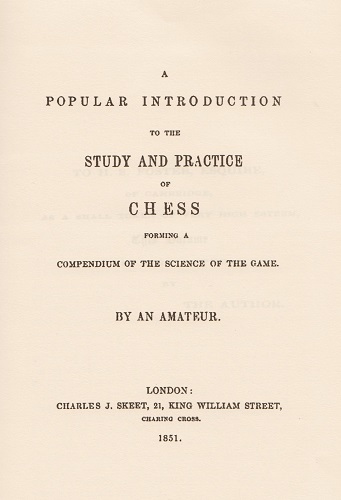
From page 27 of A Popular Introduction to the Study and Practice of Chess (London, 1851), a book by S.S. Boden published anonymously when he was in his mid-twenties:
‘In playing, never forget the Italian maxim, “Never make a good move without first looking out for a better”. This is the golden rule of chess.’
(10087)
From page 209 of W.H.K. Pollock. A Chess Biography with 523 Games by Olimpiu G. Urcan and John S. Hilbert (Jefferson, 2017), in an annotation by Pollock in 1883:
‘The position is very peculiar, and well illustrates Steinitz’s rule, “When you have found a very good move, don’t make it, but look for a better one.”’
Page 413 has an 1894 game annotation by Pollock which reads:
‘Following Steinitz’s principle: “When you have found a good move, don’t make it but look for a better one.”’
(10484)
Many old variants of the saying can be found through a Google Books search. That link gives, for example:
‘Mr Kenny should have remembered the old chess axiom: “When you see a good move, look out for a better.”’
Source: the Chess Player’s Chronicle, 1851, page 146.
What is still lacking is a convincing explanation as to why Emanuel Lasker’s name is all too often attached to the saying.
To the Archives
for other feature articles.
Copyright Edward Winter. All rights reserved.